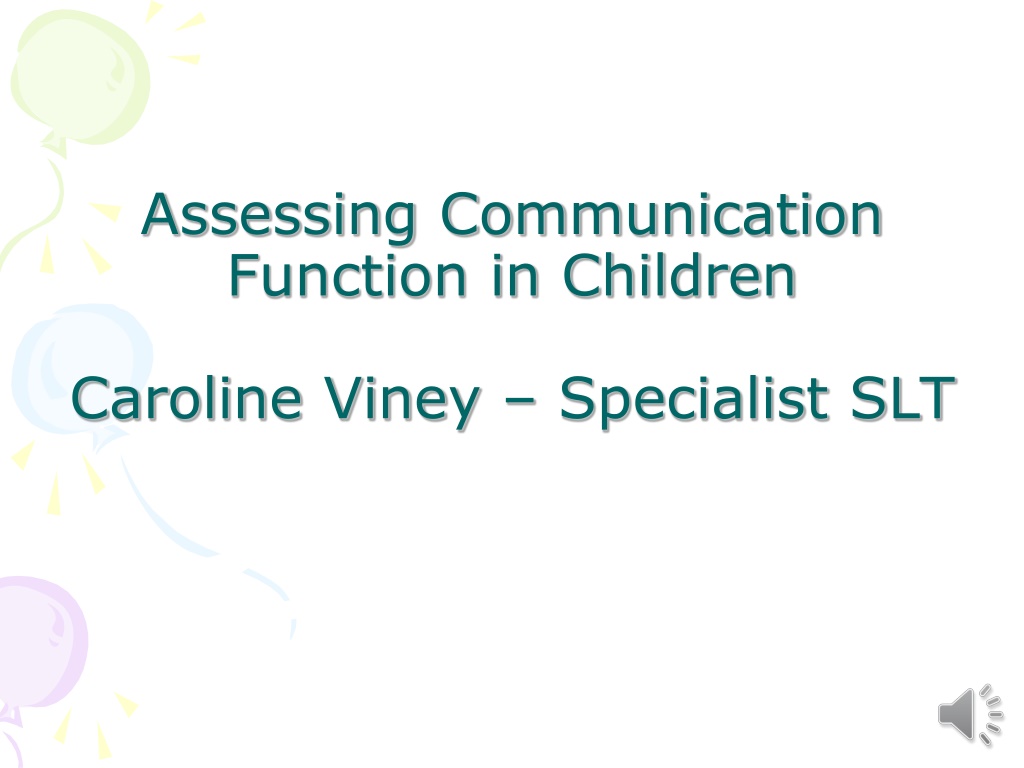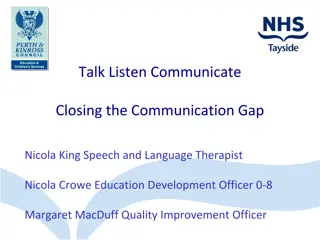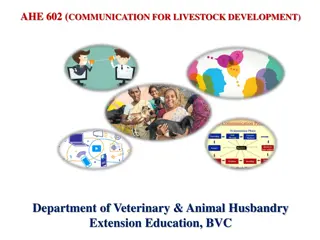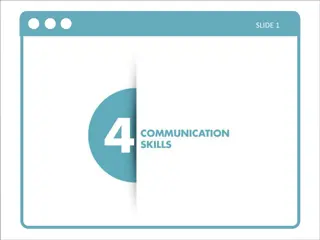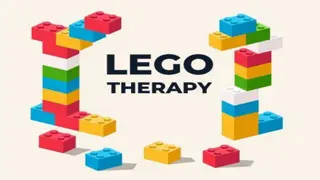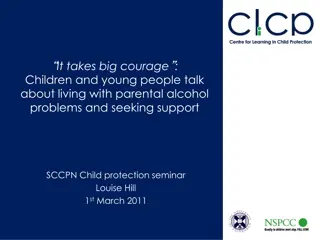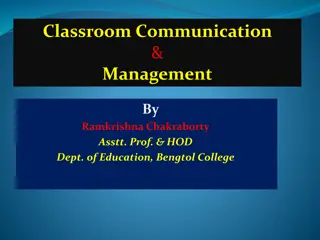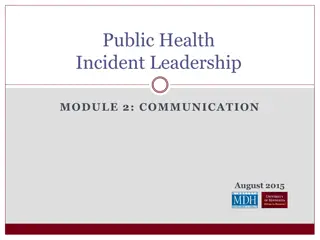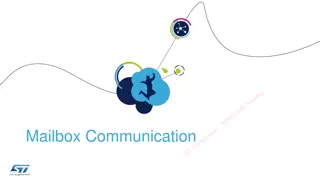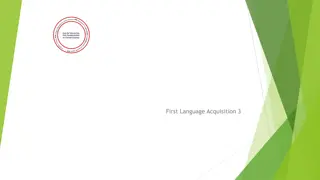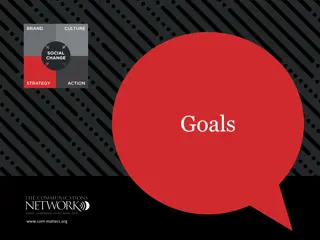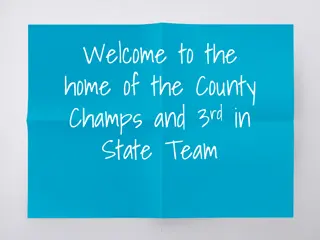Understanding Communication Development in Children by Caroline Viney
Explore the essential aspects of communication function in children, including stages of development, identifying delays versus disorders, and the impact of language on interventions. Gain insights into foundational communication skills crucial for intellectual, social, and emotional growth. Learn about the key components of communication and the pre-requisite skills needed for effective communication.
Download Presentation

Please find below an Image/Link to download the presentation.
The content on the website is provided AS IS for your information and personal use only. It may not be sold, licensed, or shared on other websites without obtaining consent from the author. Download presentation by click this link. If you encounter any issues during the download, it is possible that the publisher has removed the file from their server.
E N D
Presentation Transcript
Assessing Communication Function in Children Caroline Viney Specialist SLT
Outcomes of learning To develop a better understanding of how communication develops at different stages and ages To understand the building blocks of communication To know the difference between a language/communication delay and a developmental disorder To be more confident gathering information where communication is a concern To consider how communication and language impacts on the teams formulation of a child s difficulties To consider how a child s communication needs impacts on how clinical interventions are delivered.
Communication skills are the foundation of children s intellectual, social and emotional development. Spoken language is the key medium for learning and language development is accepted as being critical to cognitive development.
What is communication? Exchanging information for a specific purpose using verbal, non- verbal or written means Verbal Non-verbal Written Words, sentences Vocalisations Tone of voice Stress Pitch volume Eye contact Facial expressions gesture Photos Emails Texts Symbols
What are the 4 parts of communication Person/ Interaction Reason/ Why Way/ How Understanding
What are the pre-requisite skills attention skills, visual skills, auditory skills, tactile skills, imitation skills, cognitive skills, and referential knowledge
What do we need to communicate Choose words Sentence structure Have ideas EXPRESSION Reception Choose sounds Understand meaning Co-ordinate Speech muscles Understand grammar Understand Words semantics Articulate sounds Speak fluently Remember/ memory Use body language Listen/hear Follow rules of conversation Interpret non-verbals Attend and look Self monitor
Delay versus Disorder A child can have a language delay but be developing appropriately in other aspects of their development A child can be delayed across all areas of their development including language development In some cases children have specific difficulties in some or all areas of receptive and expressive language. This is now known as Developmental Language Disorder (DLD)
SPEECH SOUND SPEECH SOUND DEVELOPMENT DEVELOPMENT Motivation VERBAL CONVERSATIONS VERBAL CONVERSATIONS Environment UNDERSTANDING AND USING PHRASES AND UNDERSTANDING AND USING PHRASES AND SENTENCES SENTENCES Parent/child interaction Stimulation SIMPLE CONVERSATIONS SIMPLE CONVERSATIONS Nurture/ USING SINGLE WORDS USING SINGLE WORDS Play Trauma VERBAL UNDERSTANDING VERBAL UNDERSTANDING GESTURE GESTURE POINTING POINTING SITUATIONAL UNDERSTANDING SITUATIONAL UNDERSTANDING TURN TURN- -TAKING TAKING BABBLE BABBLE VOCALISATION VOCALISATION Motor skills HEARING HEARING ATTENTION ATTENTION LISTENING LISTENING LOOKING LOOKING
Group discussion Think about a child you have recently seen where you have had a concern about all or aspects of their communication. Using the building blocks indicate how they were functioning in each of the areas starting from the bottom.
What have the experts said about language? Naom Chomsky The Human Brain has a naturally built in template for the learning of language Lev Vygotsky Language development is dependant on the interaction with others BF Skinner language learning is pushed through a reward-response system Jean Piaget Language develops instrinsically with other cognitive skills such as processing, memory, reasoning, empathy and inference . Howard Gardener language deficiency should not be used as a defining measure of intelligence but as one of many types of intelligence
By six months... Babies communicate from day one. As they develop, they begin to watch the adults around them and start making noises. They will communicate with adults by watching their faces and might try to copy what they do. Being able to copy is important for young babies it is how they learn. By six months, babies will usually: make sounds, like cooing, gurgling and babbling, to themselves and with other people make noises to get your attention watch your face when you talk to them get excited when they hear voices coming, maybe by kicking or waving their arms or making noises smile and laugh when other people smile and laugh make sounds back when talked to
By one year... Babies communicate in more ways now making noises, pointing and looking to get your attention. They start to understand routines, simple words and activities. By one year, babies will usually: make talking noises - babble strings of sounds, like ma-ma-ma , ba-ba-ba point and look at you to get your attention many, though not all 1 year olds, will be saying their first words and they may also use gestures start to understand words like bye-bye and up especially when a gesture is used at the same time recognise the names of familiar objects, things like cup and bowl , teddy and mummy look at you when you speak or when they hear their name called take turns in conversations , babbling back to an adult
By 18 months... This is a very exciting time babies will be starting to talk now. Not everyone will understand but they are having a good try at saying a handful of words. By 18 months, babies will usually: be talking but not all will be talking and this is ok. Most importantly they will understand some simple words and short phrases. These are usually things they hear a lot during the day, such as coat on , drink , shoes , bus , in your buggy , dinner time , all gone Recognise and point to familiar objects when you ask them enjoy games like peek-a-boo and pata-cake and toys that make a noise
By two years... Their understanding of words and phrases grows really quickly during this time. They often understand much more than they say. This can result in frustration when they don t get their message across. By two years, toddlers will usually: understand between 200 and 500 words use 50 or more single words like juice , car , biscuit though some children may not be using many words and this is not in itself a cause for concern be starting to put short sentences together with two to three words, such as more juice or bye- bye daddy be asking simple questions such as what that? , who that? . They might do this quite a lot! understand simple questions and instructions like where s baby , go get your coat , mummy s turn enjoy pretend play with their toys, such as feeding dolly or pretending to drive a car, usually making noises and talking while playing become very frustrated when they cannot get their message across. This is one reason for toddler tantrums!
By three years... By three years, children will usually: They will use different types of words to do different things, e.g. to describe what things look like big , soft where they are under , on what they are for eating , playing that say who they are me to describe how many - lots refer to something that has happened in the past put 4 or 5 words together to make short sentences, such as me want more juice , ask lots of questions have clearer speech, although they will still have some immaturities. people who know them can understand them better. listen to and remember simple stories with pictures understand longer instructions, such as put on your coat and get your bag or where s mummy s coat? understand simple who , what and where questions though not all do play more with other children and join in with play play more complex imaginative games be able to have a proper conversation, though they may flit around the topic a bit and be difficult to follow at times be able to recognise how other people feel and will try to do something about it e.g Ah,Josie sad. She need a hug
By four years. ask lots of questions using words like what , where and why be able to answer questions about why something has happened use longer sentences and link sentences together, e.g. I had pizza for tea and then I played in the garden describe events that have already happened, e.g. We got dressed up and we went to the hall and singed songs. All the mummies and daddies did watch have mostly clear speech, though can continue to have difficulties with some sounds number of sounds for example r as in rabbit, l as in letter, th as in thumb, sh as in show, and j as in jam listen to longer stories and answer questions about a story they have just heard understand and often use colour, number and time related words, for example, red car, three fingers enjoy make-believe play start to like simple jokes though often their own jokes make little sense!
By 5 years take turns in much longer conversations use sentences that are well formed, for example, I had spaghetti for tea at Jamilia s house be learning more words all the time as well as thinking more about the meanings of words, such as describing the meaning of simple words or asking what a new word means be able to re-tell short stories they have heard in roughly the right order and using language that makes it sound like a story use most speech sounds. However, they may have some difficulties with more difficult words such as scribble or elephant and some speech sounds may still be difficult enjoy listening to stories, songs and rhymes and will start to make up their own ask relevant questions or make relevant comments in relation to what they have heard understand spoken instructions without stopping what they are doing to look at the speaker understand more complicated language such as first , last , might , maybe , above and in between understand words that describe sequences such as first we are going to the shop, next we will play in the park choose their own friends use talk to take on different roles in imaginative play, to interact and negotiate with people and to have longer conversations use talk to help work out problems and organise thinking and activities
Stammering/stuttering Some children, when they are learning to talk, can stumble over words/pause and start again etc. This can sound like a stammer/stutter. Between the ages of two and five years it is normal for a child to repeat words and phrases or hesitate while they are thinking of what they are trying to say. Many children will become more fluent as they get older but others can continue to get stuck and find talking difficult. It is important to seek early intervention for these children and their families. Factors that contribute to increased risk of persistent stammering are; Positive family history Child awareness and/or signs of frustration Child has been stammering for more than 6 months Difficulties with speech and language development High levels of parental anxiety
Discussion For a recent case you have dealt with, what pre-requisites were not in place to develop language/communication . How did this present itself (using the building blocks in slide 8) How did this inform your formulation? What intervention did you choose as a result? What would you change on reflection?
Gathering information as partof an assessment where communication is a concern Case history from parents is crucial Background information and family circumstances and any trauma or gaps in child/parent interaction Birth history Medical history How language has developed Other aspects of development particularly play, self help and attention. Observe the child playing and interacting with others both family and peers.
